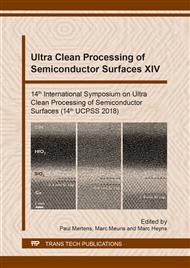p.19
p.25
p.31
p.39
p.43
p.48
p.52
p.59
p.64
Effect of WET treatment on Group III-V Compound Semiconductor Surface
Abstract:
In this work, we investigated interfacial properties of InP, which is a typical group III-V compound used for semiconductors, by using a chemical-treated metal oxide semiconductor (MOS) capacitor. The interfacial properties of InP is more affected by interface state density than the surface roughness and is greatly affected by In2O3 in particular. Additionally, we evaluated In2O3 growth during 24-hour rinsing and air exposure and found that In2O3 on an InP surface grows larger during rinsing than during air exposure. To reduce In2O3, the rinse needs to be optimized.
Info:
Periodical:
Pages:
43-47
Citation:
Online since:
August 2018
Authors:
Keywords:
Price:
Сopyright:
© 2018 Trans Tech Publications Ltd. All Rights Reserved
Share:
Citation:


